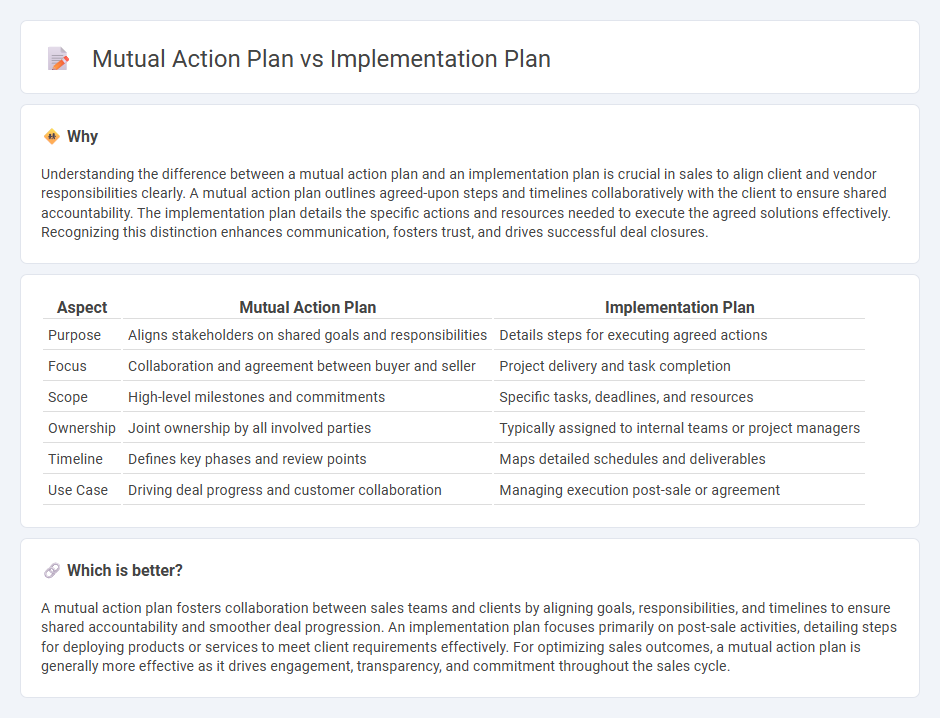
A Mutual Action Plan outlines collaborative steps between sales teams and clients to achieve shared goals, focusing on alignment and joint accountability throughout the sales process. An Implementation Plan, however, details the specific actions and timelines required to deploy a product or service post-sale, emphasizing execution and resource allocation. Explore the distinctions to optimize your sales strategy and client engagement effectively.
Why it is important
Understanding the difference between a mutual action plan and an implementation plan is crucial in sales to align client and vendor responsibilities clearly. A mutual action plan outlines agreed-upon steps and timelines collaboratively with the client to ensure shared accountability. The implementation plan details the specific actions and resources needed to execute the agreed solutions effectively. Recognizing this distinction enhances communication, fosters trust, and drives successful deal closures.
Comparison Table
| Aspect | Mutual Action Plan | Implementation Plan |
|---|---|---|
| Purpose | Aligns stakeholders on shared goals and responsibilities | Details steps for executing agreed actions |
| Focus | Collaboration and agreement between buyer and seller | Project delivery and task completion |
| Scope | High-level milestones and commitments | Specific tasks, deadlines, and resources |
| Ownership | Joint ownership by all involved parties | Typically assigned to internal teams or project managers |
| Timeline | Defines key phases and review points | Maps detailed schedules and deliverables |
| Use Case | Driving deal progress and customer collaboration | Managing execution post-sale or agreement |
Which is better?
A mutual action plan fosters collaboration between sales teams and clients by aligning goals, responsibilities, and timelines to ensure shared accountability and smoother deal progression. An implementation plan focuses primarily on post-sale activities, detailing steps for deploying products or services to meet client requirements effectively. For optimizing sales outcomes, a mutual action plan is generally more effective as it drives engagement, transparency, and commitment throughout the sales cycle.
Connection
A mutual action plan aligns sales teams and clients by outlining shared goals, timelines, and responsibilities, ensuring transparency and collaboration throughout the sales process. An implementation plan builds on this foundation by detailing the specific steps and resources required to execute the agreed-upon actions, facilitating smooth project delivery and client satisfaction. Together, these plans drive accountability, streamline communication, and increase the likelihood of successful deal closure and long-term partnerships.
Key Terms
**Implementation Plan:**
An Implementation Plan outlines detailed steps, timelines, resources, and responsibilities required to execute a project or strategy effectively, ensuring all tasks progress as scheduled to achieve desired outcomes. Unlike a Mutual Action Plan, which emphasizes collaborative milestones and shared accountability between parties, the Implementation Plan focuses on internal execution and operational workflow. Explore our comprehensive guide to mastering Implementation Plans for successful project delivery.
Timeline
An implementation plan outlines detailed activities, deadlines, and responsible parties to achieve project goals within a fixed timeline. A mutual action plan emphasizes collaboration between stakeholders, aligning tasks and milestones to ensure shared accountability and timely progress. Explore more to understand how tailored timelines drive successful project outcomes.
Milestones
An implementation plan outlines the specific tasks, timelines, and resource allocations necessary to achieve project goals, emphasizing clear milestones for tracking progress. A mutual action plan centers on collaborative agreement between parties, highlighting shared milestones and responsibilities to ensure alignment and accountability. Explore deeper insights into how milestone-focused strategies enhance project success.
Source and External Links
Implementation Plan Template and Examples - This resource provides a detailed implementation plan template designed to guide teams through four stages: exploration, installation, initial implementation, and full implementation, including setting goals, timelines, responsible persons, needed resources, and data tracking for progress.
Implementation Plan: Definition and Examples - Explains how to turn strategy into action by defining project scope, objectives, tasks, roles, timelines, and milestones to ensure smooth execution and measurable success.
What Is Implementation Planning? And How to Write Your ... - Covers the components of an implementation plan such as objectives, scope, strategy, resources, schedule, roles, and metrics, and breaks down the four stages of implementation to help manage the process effectively.
 dowidth.com
dowidth.com